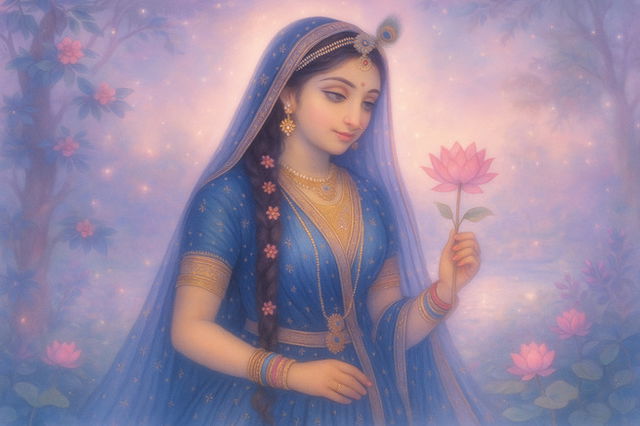Radhashtami is observed every year on the eighth day of Shukla Paksha, or the bright half of the Bhadrapada month, according to the Hindu calendar.
This holiday, also called Radha Jayanti, celebrates the birth anniversary of Goddess Radha, who was married to Lord Krishna and was very close to him.
It typically falls fifteen days after Janmashtami, landing in August or September on the Gregorian calendar.
Radhashtami 2025 Date and Timings
Radha Ashtami in 2025 will be observed on Sunday, 31 August, with Ashtami Tithi beginning at 10:46 PM on 30 August 2025 and ending at 12:57 AM on 01 September 2025; the Madhyahna Puja Muhurat is from 11:05 AM to 01:38 PM, lasting 2 hours and 33 minutes.

The Story of Radhashtami
Goddess Radha is believed to be the eternal consort of Lord Krishna and the embodiment of divine love and devotion.
The story of Radhashtami revolves around the appearance of Goddess Radha and her deep spiritual connection with Lord Krishna.
According to Hindu mythology, Radha was born in the village of Barsana, close to Mathura, more than 5,000 years ago.
Her divine appearance was meant to complement the earthly pastimes of Lord Krishna and to symbolize the highest form of bhakti or devotion.
The story begins with King Vrishabhanu and his wife Kirtida, who longed for a child.
One day, while walking near a pond, they found a golden lotus, and inside it, a radiant baby girl. This child was Radha, born not from a womb, but manifested directly from divine energy.
According to folktales, Radha did not open her eyes at birth. It is believed she waited until she could behold Lord Krishna, her eternal beloved.
When Krishna appeared before her in Gokul, Radha opened her eyes for the first time, marking the beginning of their eternal bond.
Radha was raised in Barsana, and as she grew, her love and devotion towards Krishna grew deeper.
Their relationship was not merely a romantic one but a symbol of the soul’s yearning for union with the divine.
The Bhumi Khanda of the Padma Purana describes the significance of Radhashtami in great detail.
The Vishnu Khanda of the Skanda Purana mentions that Krishna had 16,000 gopis, yet Radha held the most prominent place in his heart.
She was not just another devotee, she was devotion itself.
Her leelas with Krishna, particularly the Raas Leela, are celebrated on this day with great fervor, representing the bliss of divine love.
Rituals of Radhashtami
On Radha Ashtami, devotees begin the day by waking up early during Brahma Muhurta, taking a holy bath, and wearing clean, preferably yellow or white traditional clothes.
The puja space is cleaned and decorated with flowers and rangoli.
A kalash (sacred pot) is placed with water, mango leaves, and a coconut on top, symbolizing divine presence.
After taking a sankalp or oath to observe the fast with devotion, the deities are bathed with panchamrit, a mix of milk, curd, honey, ghee, and sugar, followed by dressing them in fresh clothes and adorning them with flowers.
Offerings of satvik food such as fruits, poha, panjiri, and kheer are placed before the deities.
Devotees offer flowers (pushpanjali) while chanting Radha-Krishna mantras like “Om Radhayai Namah” or “Jai Shri Radhe.” Aarti is performed with incense sticks, a ghee lamp, and ringing of bells.
After aarti, devotees listen to or recite the Radha Ashtami katha and sing bhajans or Raas Leela songs glorifying Radha’s devotion.
In the evening, a diya is lit again, Tulsi leaves are offered to Lord Krishna, and devotees continue chanting Radha and Krishna’s names, often completing a 108-name japa of Radha.
The fast is broken after evening prayers with a satvik meal or the next morning, depending on tradition.
Mantras chanted on Radhashtami include: Aum Vrashbhanujaye Vidmahe, Krishnapriyaye Dheemahi, Tanno Radha Prachodayat and Radhe Radhe.
Observances of Radhashtami Across The Country
Radhashtami is celebrated with devotion in temples linked to Radha Vallabh Sampradaya, Gaudiya Vaishnavism, Nimbarka Sampradaya, Pushtimarg, and Haridasi Sampradaya.
In places like the Radha Vallabh Temple and Seva Kunj in Vrindavan, celebrations last nine days with processions of Radha-Krishna, music, dance, and distribution of food and clothes.
Gaudiya Vaishnavas, including ISKCON followers, observe Radha Ashtami with fasting. Most keep a half-day fast, while some observe a full-day or even a waterless fast.
In ISKCON temples, Radharani is honored with a special mahabhishek (ritual bath).
In the Braj region, idols of Radha-Krishna are dressed entirely in flowers. It’s the only day when devotees can view Radha’s feet, which are kept covered throughout the rest of the year.
You might like reading Janmashtami .